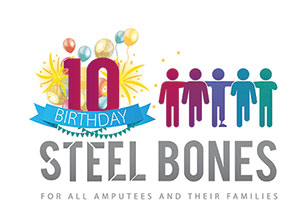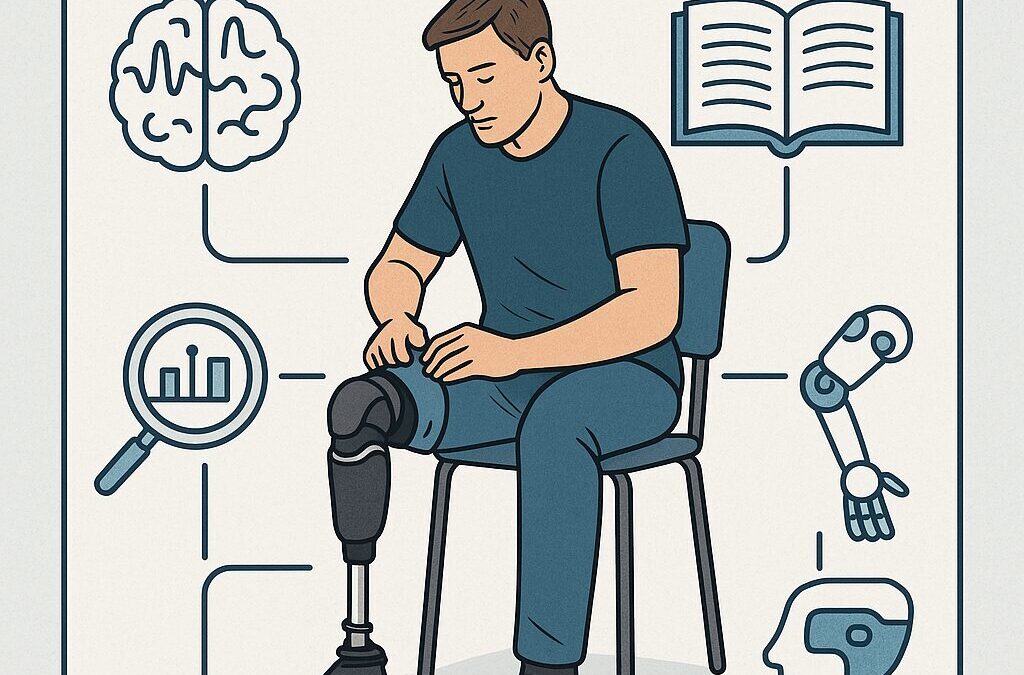Staying on top of good evidence helps all of us make smarter choices—whether that’s easing phantom limb pain, finding a better-fitting socket, or deciding if a microprocessor knee or osseointegration is right for you. We’ve sifted through recent, credible studies and translated them into plain English with quick “why it matters” notes. Dip into the sections that speak to you—pain and neuromas, prosthetics and fall risk, skin and sweating, exercise and balance, mental wellbeing, and the latest upper-limb tech.
This isn’t about lab jargon; it’s about practical takeaways you can discuss with your prosthetist, physio, or surgeon, and share with your peer-support group. If something sparks a question, tell us—your experiences help us decide what to dig into next and what to feature in workshops and newsletters.
Friendly reminder: these highlights summarise research and aren’t medical advice. Your clinical team knows your situation best.
Pain, neuromas & phantom limb pain (PLP)
- NICE evidence review on Targeted Muscle Reinnervation (TMR) for amputation pain (2025). Broad UK-focused overview pulling together RCTs and cohort studies; useful when discussing options with your surgical team. NICE
- Prospective study: TMR improves residual-limb pain, PLP and function (2020). Shows meaningful pain and function gains after TMR. PMC
- Regenerative Peripheral Nerve Interface (RPNI) – clinical review & outcomes (2023–2025). Summarises how RPNI treats neuromas/PLP and doubles as a control interface for advanced prostheses. Lippincott JournalsPMC+1
- Mirror therapy meta-analyses (2021–2022). Short-term PLP reductions are consistent; long-term effects less certain. Useful as a low-risk home strategy. PubMed+1
- Calcitonin for acute PLP—evidence roundup (1987–2023). Small trials and reviews suggest early analgesic benefit in some patients; still niche but worth knowing. PMCPubMedLippincott Journals
Prosthetic knees & fall risk (transfemoral)
- K2/limited community ambulators using C-Leg (2021). 13-month clinical trial showed mobility/satisfaction benefits even in less active users. PMC
- MPK use linked to fewer injurious falls (2023). Real-world analysis associating MPKs with lower odds of serious falls. Taylor & Francis Online
- Randomised/crossover and pilot RCTs (2011–2025). Multiple trials report functional gains and reduced falls versus non-MPKs; new SAFE-AMP and ACME studies extend this to early rehab. Medical JournalsPMCTaylor & Francis OnlineWiley Online Library
Powered ankles & energy use (transtibial)
- Powered vs passive-elastic feet reduce metabolic cost (2018–2022). Lab and emulator studies show lower energy cost on level and slope walking—translates to less fatigue for some users. Royal Society Publishing+1
- Recent biomechanics work (2024). Variable-stiffness/low-power concepts aim to make these benefits more practical for daily life. NatureCambridge University Press & Assessment
Osseointegration (bone-anchored prostheses)
- Complications & outcomes after transfemoral osseointegration (2024). Open-access review of infection, fracture, and functional results—balanced view of risks/benefits. PMC
- Upper-limb (transhumeral) osseointegration perspective (2024). Highlights potential QoL gains and where evidence is strongest/weakest. Lippincott Journals
- Recent overview & patient-selection discussions (2025). Useful for members considering socket intolerance vs. surgical options. PMCScienceDirect
Sockets, liners & residual-limb skin care
- Residual-limb hyperhidrosis review (2021). Practical therapies (antiperspirants, botulinum toxin, device tweaks) and how to measure sweating burden. Lippincott Journals
- Temperature-control/phase-change liners (2022). Early evidence suggests better prosthesis use trends; results mixed—worth discussing with your prosthetist. Lippincott Journals
- Adaptive, self-adjusting socket (2024). Take-home testing shows automatic volume adjustment can help manage fit changes through the day. Nature
Exercise, balance & day-to-day function
- Exercise interventions meta-analyses (2022–2024). Multicomponent programmes (strength, balance, gait) improve walking and balance at subacute and chronic stages. Great talking point for rehab classes. PubMed+1
- Personalised exercise reduces falls & improves gait (2025). Early RCT signals support structured, tailored training. ScienceDirect
Mental health & quality of life
- QoL after lower-limb amputation—quanti-qualitative review (2023). Shows how pain control, prosthesis use and social support drive QoL—good for peer-support agendas. PMC
- Mental health strongly linked to capabilities after major limb injury (2024). Underlines the value of psychological support in rehab. SpringerLink
Upper-limb tech & sensation (for our arm-difference members)
- Biological sensorimotor interfaces & RPNI for hand control (2024–2025). Progress toward intuitive control and long-term sensory feedback with implanted interfaces. NaturePMC
- Peripheral-nerve stimulation for touch with prosthetic hands (2023). Demonstrates stable, bidirectional sensation over months—key step for dexterity and embodiment. Nature


Recent Comments